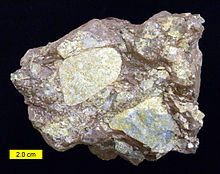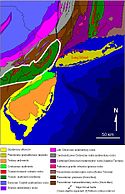- Newark Group
-
The Newark Group, also known as the Newark Supergroup, is an assemblage of Late Triassic and Early Jurassic sedimentary rocks which outcrop intermittently along the United States East Coast; the exposures extend from Massachusetts to North Carolina, with more still in Nova Scotia. It is named for the city of Newark, New Jersey.
Contents
Characteristics
 New Oxford Conglomerate (Upper Triassic, York County, Pennsylvania); a unit within the Newark Group.
New Oxford Conglomerate (Upper Triassic, York County, Pennsylvania); a unit within the Newark Group.
The Newark Group consists largely of poorly-sorted nonmarine sediments; typical rocks are breccia, conglomerate, arkose sandstone, siltstone, and shale.[1][2] Most of the strata are red beds that feature ripple marks, mud cracks, and even rain drop prints; dinosaur footprints are common, though actual body fossils are very rare.[3] Some of the strata are detailed to the level of varves, with indications of Milankovitch cycles.[4] In preserved lake sediments, Semionotus fossils are especially common.[5]
The Newark sediments are extremely thick (up to 6 kilometers); they were deposited in a series of half-grabens that were themselves faulted into block mountains.[6] The beds dip to the east, while the faults dip westward.[7] The beds are intruded by numerous dikes and sills, indicative of considerable igneous activity; a superb example is the New Jersey Palisades sill.[8]
Formation
The Newark Group's lithologies and structure are the classic hallmarks of a rift valley; the fault-blocking illustrates the crustal extension forces in play during the breakup of Pangea during the late Triassic Period.[9] The Appalachian Mountains had already been nearly eroded flat by the end of the period; the uplift and faulting that was the first part of the rifting provided new sources of sediment for the vast thicknesses deposited in the Newark Group; the igneous intrusions are similarly diagnostic of a rift valley.[10] Coarse sediments were deposited near the eastern mountain front, while progressively finer ones were deposited farther west.[11]
Evidence suggests the climate at the time was subtropical and rainy, though divided between wet and dry months.[12] A few organic-rich deposits suggest patchy or intermittent swamps and lakes.[13]
Accumulation of Newark sediments continued from the late Triassic into the early Jurassic.[14]
See also
Footnotes
- ^ James Monroe and Reed Wicander, The Changing Earth: Exploring Geology and Evolution, 2nd ed. (Belmont: West Publishing Company, 1997), p. 602.
- ^ Carl Schuchert and Carl Dunbar, Outlines of Historical Geology, 4th ed. (New York: John Wiley & Sons, Inc., 1947), p. 108.
- ^ Schuchert and Dunbar, p. 108.
- ^ Michael J. Benton, The Penguin Historical Atlas of the Dinosaurs, (London: Penguin Books Ltd., 1996), 88-9.
- ^ Ibid.
- ^ Monroe and Wicander, p. 605
- ^ Ibid.
- ^ Ibid.
- ^ Monroe and Wicander, p. 602.
- ^ Monroe and Wicander, pp. 602,605.
- ^ Schuchert and Dunbar, p. 109
- ^ Ibid.
- ^ Schuchert and Dunbar, pp. 108-9.
- ^ Monroe and Wicander, p. 602.
External links
- "Materials to Accompany Olsen et al. Science Article." Retrieved on 12/18/06.
- "Newark Supergroup." Retrieved on 12/18/06.[dead link]
Triassic Traprock
RidgesCampgaw Mountain • Preakness Range • Goffle Hill • Newark MountainsWatchung Outliers Ladentown • Union Hill • New Germantown/Oldwick • Prospect Hill • Sand Brook • JacksonwaldHudson River Palisades • High Tor • Hook Mountain • Clausland Mountan • Tallman Mountain • Snake HillOther Intrusions Cushetunk Mountain • Sourland Mountain • Rocky Hill Ridge • Mount Gilboa • Bowman’s Hill • Solebury Mountain • Buckingham Mountain • Jericho Mountain • Haycock Mountain • Millers PointFaults
Eastern North America Rift BasinsRamapo Fault Hopewell Fault • Flemington Fault • Chalfont FaultCategories:- Geological supergroups
- Historical geology
- Triassic geologic formations
- Jurassic geologic formations
- Geology of Massachusetts
- Geology of North Carolina
- Geology of New Jersey
- Geology of Nova Scotia
Wikimedia Foundation. 2010.

